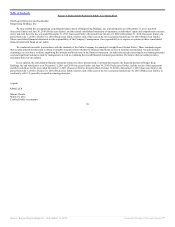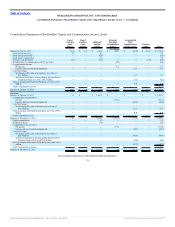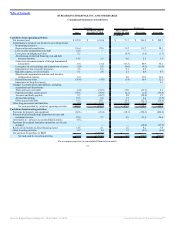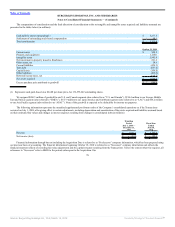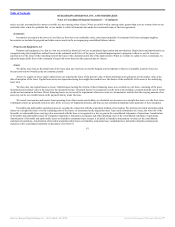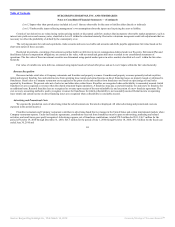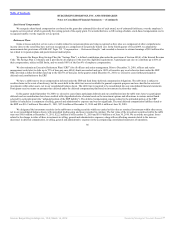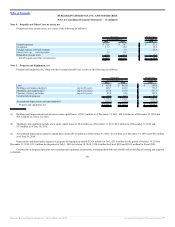Burger King 2011 Annual Report Download - page 81
Download and view the complete annual report
Please find page 81 of the 2011 Burger King annual report below. You can navigate through the pages in the report by either clicking on the pages listed below, or by using the keyword search tool below to find specific information within the annual report.
Table of Contents
BURGER KING HOLDINGS, INC. AND SUBSIDIARIES
Notes to Consolidated Financial Statements — (Continued)
Four distributors currently service approximately 85% of our U.S. system restaurants and the loss of any one of these distributors would likely adversely
affect our business. In many of our international markets, a single distributor services all the Burger King restaurants in the market. The loss of any of one of
these distributors would likely have an adverse effect on the market impacted, and depending on the market, could have an adverse impact on our financial
results.
Use of Estimates
The preparation of financial statements in conformity with accounting principles generally accepted in the United States (“GAAP”) requires management
to make estimates and assumptions that affect the amounts reported in our consolidated financial statements and accompanying notes. Management adjusts such
estimates and assumptions when facts and circumstances dictate. Volatile credit, equity, foreign currency, and energy markets and declines in consumer spending
may continue to affect the uncertainty inherent in such estimates and assumptions. As future events and their effects cannot be determined with precision, actual
results could differ significantly from these estimates.
Foreign Currency Translation
The functional currency of each foreign subsidiary is generally the local currency. Foreign currency balance sheets are translated using the end of period
exchange rates, and statements of operations are translated at the average exchange rates for each period. The translation adjustments resulting from the
translation of foreign currency financial statements are recorded in accumulated other comprehensive income (loss) within stockholders’ equity.
Foreign Currency Transaction Gains or Losses
Foreign currency transaction gains or losses resulting from the re-measurement of our foreign-denominated assets and liabilities or our subsidiaries are
reflected in earnings in the period when the exchange rates change and are included within other operating (income) expenses, net in the consolidated statements
of operations.
Cash and Cash Equivalents
Cash and cash equivalents include short-term, highly liquid investments with original maturities of three months or less and credit card receivables.
Allowance for Doubtful Accounts
We evaluate the collectibility of our trade accounts receivable from franchisees based on a combination of factors, including the length of time the
receivables are past due and the probability of collection from litigation or default proceedings, where applicable. We record a specific allowance for doubtful
accounts in an amount required to adjust the carrying values of such balances to the amount that we estimate to be net realizable value. We write off a specific
account when (a) we enter into an agreement with a franchisee that releases the franchisee from outstanding obligations, (b) franchise agreements are terminated
and the projected costs of collections exceed the benefits expected to be received from pursuing the balance owed through legal action, or (c) franchisees do not
have the financial wherewithal or unprotected assets from which collection is reasonably assured.
Notes receivable represent loans made to franchisees arising from refranchisings of Company restaurants, sales of property, and in certain cases when past
due trade receivables from franchisees are restructured into an interest-bearing note. Trade receivables restructured to interest-bearing notes are generally already
fully reserved,
80
Source: Burger King Holdings Inc, 10-K, March 14, 2012 Powered by Morningstar® Document Research℠


